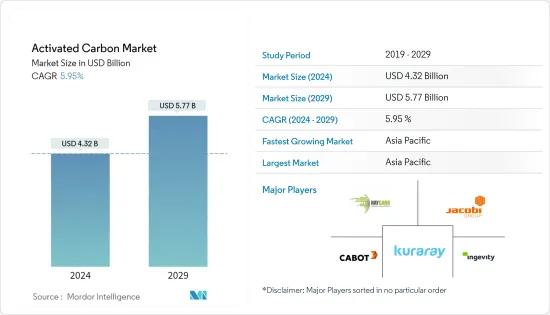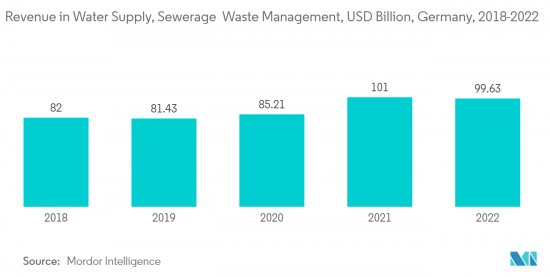PUBLISHER: Mordor Intelligence | PRODUCT CODE: 1404099

PUBLISHER: Mordor Intelligence | PRODUCT CODE: 1404099
Activated Carbon - Market Share Analysis, Industry Trends & Statistics, Growth Forecasts 2024 - 2029

The Activated Carbon Market size is estimated at USD 4.32 billion in 2024, and is expected to reach USD 5.77 billion by 2029, growing at a CAGR of 5.95% during the forecast period (2024-2029).
The market was negatively impacted by the COVID-19 pandemic as the demand was reduced, considering the temporary halt of activities in various end-user industries, such as metal extraction and others. However, since the end of the pandemic, the demand for the market studied has picked up the pace and is likely to grow at a significant rate in the coming years.
Key Highlights
- In the medium term, major factors driving the market are conformance to stringent environmental regulations in water treatment applications in the United States and the increasing prominence of air pollution control (especially mercury removal).
- Narrower markets, due to the increased costs of some grades of activated carbon, the threat of substitutes like silica gel, and the development of better alternatives, are expected to hinder the growth of the market.
- Emerging applications in the medical and pharmaceutical sectors is likely to act as an opportunity for the market.
- Asia-Pacific accounted for the highest market share, and the region is likely to dominate the market during the forecast period.
Activated Carbon Market Trends
Water Treatment Industry to Dominate the Market
- Water treatment is a popular application of activated carbon. Most water treatment filters are made of granular activated carbon. It is used to remove organic-chemical substances and colorants and reduce trace substances, such as chemicals.The usage of activated carbon is one of the most effective methods for the treatment of municipal/industrial wastewater. Activated carbon is normally used in granular form to remove a wide variety of contaminants, such as nonbiodegradable organic compounds, absorbable organic halogens, color compounds and dyestuffs, and pesticides.
- Wastewater and ballast water treatment, groundwater remediation, surface impoundments, and cleanup of groundwater and accidental spills are other applications of activated carbon. Activated carbon also helps in the removal of odors that occur in wastewater plants, where biological activity creates hydrogen sulfide (H2S), ammonia (NH3), VOCs, etc.
- In addition, federal policy programs, including the Safe Drinking Water Act and the Clean Water Act coordinated by the Environmental Protection Agency (EPA), provide treatment and discharge regulations, funding programs, and frameworks for operating and applying innovative water and wastewater treatment technologies. Hence, this is further expected to boost the demand for activated carbons from the water treatment segment.
- China has 10,113 water treatment plants that treat wastewater for 95% of municipalities and 30% of rural areas. Moreover, in the 14th Five-year Plan, released in March 2021, China published new guidelines for wastewater reuse, which mandated raising the proportion of sewage that must be treated to reuse standards to 25% by 2025.
- Water treatment is a popular application of activated carbon. Most water treatment filters are made of granular activated carbon. It is used to remove organic-chemical substances and colorants and reduce trace substances such as chemicals. The usage of activated carbon is one of the most effective methods for the treatment of municipal/industrial wastewater. Activated carbon is normally used in granular form to remove a wide variety of contaminants, such as nonbiodegradable organic compounds, absorbable organic halogens, color compounds and dyestuffs, and pesticides.
- The German water treatment technology market is the largest in Europe and is growing considerably. According to the Eurostat and Statistisches Bundesamt, the revenue of Germany's water supply, sewerage, and waste management industry generated USD 99.63 billion in 2022.
- Therefore, considering the growth trends and various projects of water treatment in different regions worldwide, the water treatment industry is likely to dominate the market, which, in turn, is expected to enhance the demand for activated carbon during the forecast period.

Asia-Pacific to Dominate the Market
- The Asia-Pacific region dominated the activated carbon market in 2022 with a considerable volume share, and it is expected to maintain its dominance during the forecast period.
- In recent years, China has increased the use of treated water to reduce its dependency on fresh water. With a tough regulatory framework and the increasing importance of water reuse in China's five-year plans (FYPs), the country is rapidly moving toward enhancing its water treatment industry for a sustainable future.
- According to the International Trade Administration, China plans to build or renovate 80,000 km of sewage collection pipeline networks and increase sewage treatment capacity by 20 million cubic meters/day between 2021 and 2025.
- China has a recognized market for pharmaceuticals and is the fastest emerging market for activated carbons. The country has a large and diverse domestic drug industry, comprising around 5,000 manufacturers, of which many are small- or medium-sized.
- In India, the Water Supply and Sewerage Board of Bangalore selected SUEZ to support the city and improve wastewater infrastructures. The group is expected to build a new wastewater treatment plant of 150,000 m3/day capacity, including the rehabilitation of an existing plant, with a capacity of 150,000 m3/day and the building of a sewage sludge recycling and recovery plant, for the sludge coming from these two plants. This increase in focus on water treatment in the country is expected to drive the activated carbon market growth.
- As per the India Brand Equity Foundation (IBEF), the country's annual production of automobiles in FY 2022 was nearly 22.93 million. Automotive production accounts for 49% of the country's GDP, and hence, the growth in this sector is liable to increase the demand for activated carbon in India.
- The Indian food industry is one the prominent industries in the country. The increasing population is another factor boosting the demand for the food industry, which, in turn, is estimated to boost the activated carbon market in India. There are 42 mega food parks located in 24 states in India, sanctioned by the Ministry of Food Processing Industry, which are in different stages of implementation.
- Thus, the reasons mentioned above are likely to fuel the growth of the activated carbon market in Asia-Pacific during the forecast period.
Activated Carbon Industry Overview
The activated carbon market is partially consolidated, with several companies operating on both global and regional levels. Some of the major players in the market (not in any particular order) include Kuraray Co. Ltd, Cabot Corporation, Ingevity, Jacobi Carbons Group, and Haycarb (Pvt.) Ltd.
Additional Benefits:
- The market estimate (ME) sheet in Excel format
- 3 months of analyst support
TABLE OF CONTENTS
1 INTRODUCTION
- 1.1 Study Assumptions
- 1.2 Scope of the Study
2 RESEARCH METHODOLOGY
3 EXECUTIVE SUMMARY
4 MARKET DYNAMICS
- 4.1 Drivers
- 4.1.1 Conformance to Stringent Environmental Regulations in Water Treatment Applications in the United States
- 4.1.2 Augmenting Prominence for Air Pollution Control (Especially Mercury Removal)
- 4.2 Restraints
- 4.2.1 Narrower Markets Due to Increased Costs of Some Grades of Activated Carbon
- 4.2.2 Threat of Substitutes Like Silica Gel and Development of Better Alternatives
- 4.3 Industry Value Chain Analysis
- 4.4 Industry Attractiveness - Porter's Five Forces Analysis
- 4.4.1 Bargaining Power of Suppliers
- 4.4.2 Bargaining Power of Consumers
- 4.4.3 Threat of New Entrants
- 4.4.4 Threat of Substitute Products and Services
- 4.4.5 Degree of Competition
5 MARKET SEGMENTATION (Market Size in Volume)
- 5.1 By Product Type
- 5.1.1 Powdered Activated Carbons (PAC)
- 5.1.2 Granular Activated Carbons (GAC)
- 5.1.3 Extruded or Pelletized Activated Carbon
- 5.2 By Application
- 5.2.1 Gas Purification
- 5.2.2 Water Purification
- 5.2.3 Metal Extraction
- 5.2.4 Medicine
- 5.2.5 Other Applications
- 5.3 By End-user Industry
- 5.3.1 Water Treatment
- 5.3.2 Food and Beverage
- 5.3.3 Healthcare
- 5.3.4 Automotive
- 5.3.5 Industrial Processing
- 5.3.6 Other End-user Industries
- 5.4 By Geography
- 5.4.1 Asia-Pacific
- 5.4.1.1 China
- 5.4.1.2 India
- 5.4.1.3 Japan
- 5.4.1.4 South Korea
- 5.4.1.5 Rest of Asia-Pacific
- 5.4.2 North America
- 5.4.2.1 United States
- 5.4.2.2 Canada
- 5.4.2.3 Mexico
- 5.4.3 Europe
- 5.4.3.1 Germany
- 5.4.3.2 United Kingdom
- 5.4.3.3 France
- 5.4.3.4 Italy
- 5.4.3.5 Spain
- 5.4.3.6 Rest of Europe
- 5.4.4 South America
- 5.4.4.1 Brazil
- 5.4.4.2 Argentina
- 5.4.4.3 Rest of South America
- 5.4.5 Middle East and Africa
- 5.4.5.1 Saudi Arabia
- 5.4.5.2 South Africa
- 5.4.5.3 Rest of Middle East and Africa
- 5.4.1 Asia-Pacific
6 COMPETITIVE LANDSCAPE
- 6.1 Mergers and Acquisitions, Joint Ventures, Collaborations, and Agreements
- 6.2 Market Ranking Analysis
- 6.3 Strategies Adopted by Leading Players
- 6.4 Company Profiles
- 6.4.1 Advanced Emissions Solutions Inc.
- 6.4.2 Albemarle Corporation
- 6.4.3 Cabot Corporation
- 6.4.4 Carbon Activated Corporation
- 6.4.5 CARBOTECH
- 6.4.6 CPL Activated Carbons
- 6.4.7 Donau Carbon GmbH
- 6.4.8 Evoqua Water Technologies LLC
- 6.4.9 Haycarb (Pvt.) Ltd
- 6.4.10 Ingevity
- 6.4.11 Jacobi Carbons Group
- 6.4.12 Kuraray Co. Ltd
- 6.4.13 Kureha Corporation
- 6.4.14 Puragen Activated Carbons
- 6.4.15 Silcarbon Aktivkohle GmbH
- 6.4.16 Veolia (Veolia Water Technologies)
7 MARKET OPPORTUNITIES AND FUTURE TRENDS
- 7.1 Emerging Applications in the Medical and Pharmaceutical Sectors




